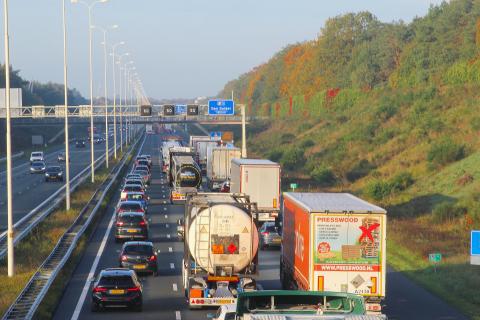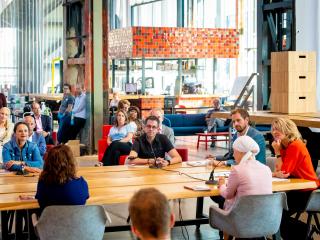Delivering the corona vaccine: a colossal logistical operation
With corona vaccines coming to market, the big question is how they can reach the public. How to organize the logistics to inoculate so many people? An interview with Jan Fransoo, Professor of Operations and Logistics Management at Tilburg University.
From the moment the corona crisis erupted, scientists have been working to develop vaccines, and in all probability a number of these will soon be released for use. This ushers in a new stage, one that is also vital, but has so far not attracted a great deal of attention. Making the vaccine is hardly the end of it. “It needs to be distributed, not just nationally, but globally. That is a colossal operation”, says Jan Fransoo.
At the time of the interview, vaccines were already being produced by such pharma companies as BioNTech/Pfizer, AstraZeneca, and Moderna. The huge logistical operation begins as soon as trucks pick up the doses at these manufacturers’ facilities. The first question is whether there are enough vehicles to begin with. “I’m not worried about that. There’s plenty of truckload capacity. In Europe, most deliveries will be done by road. We’re used to doing that here”, Fransoo says. “Outside the EU it’s a different story. In the US, for example, huge quantities of cargo are shipped by air. True, on paper that happens in Europe, too: when something is carried from Schiphol to Munich, it is labeled air freight. But in actual reality it is then transported by road.”

I really don’t understand why the RIVM is being so evasive about the logistics. It’s been common knowledge for almost a year now that these vaccines are being developed.”
Assembly line
No shortage of trucks, then, but are they suitable for transporting vaccines that need to be kept at very low temperatures? The BioNTech/Pfizer vaccine is a case in point: it must be stored as well as transported at a freezing -80°C. “The regular cooling systems of trucks only allow for temperatures down to -20°C. But luckily there’s a practicable solution: vehicles can be adequately cooled using dry ice. An insulated box containing frozen CO2 placed in the loading compartment will keep the temperature in the compartment at -80°C for several days. So I don’t expect problems in this area.”
Next stop for the trucks is the distribution center, which is where the vaccines are stored in bulk. That is also how, for example, food fares: gathered from factories and farmers, it is amassed in distribution centers, from where it is then delivered to supermarkets. Or take electronics and books; these, too, are distributed through large storage facilities to retail stores all over the country. That is how it will be for the corona vaccines: they will be stored on one or more sites and subsequently delivered throughout the country.
How best to do this depends on strategic choices. There are essentially two approaches. One is to invite people to come to central locations, where they will then be vaccinated. Examples of such locations could include Ahoy, the Brabanthallen, the IJsselhallen, and the Gelredome. “That’s where large numbers of people could be vaccinated almost non-stop”, Fransoo says. A bit like assembly line inoculation. “It would be sensible to also use these megasites for storage. We’re looking at tens of thousands of people being vaccinated every day and for that to work huge quantities of vaccine must be readily available on site.” This is the line Germany is going to take. Mobile units will subsequently visit care homes and vaccinate the residents, for whom mobility is an issue.

Trucks will play a key role in distributing the vaccine
Cutting it fine
The other approach is more decentralized, for example vaccination through local, primary care. This is how the annual flu jab is administered. “Every family doctor inoculates a few thousand people every week. Logistically, that is a completely different system. Family doctors often don’t have sufficient storage capacity to stock the required large quantities of vaccine, whether deep-frozen or not. For this approach, several distribution centers would be needed regionally.”
From a strictly logistical perspective, Fransoo favors a centralized strategy. “In a decentralized game plan, there is the risk of large supplies ending up in the wrong place. And because sustained refrigeration is likely to become an issue, too many locations is inadvisable. Also, this system doesn’t naturally lend itself to ease of scaling. Of course, there is a great deal of experience with the annual flu vaccination in the Netherlands, but the number of people to be vaccinated amounts to a few million at most. With the corona virus, the target demographic is the entire population: 17 million people. That really is quite different.”
The Netherlands has yet to decide on its course of action. In reply to questions about a vaccination program, the national government agency in charge, the RIVM (the Dutch institute for public health and the environment), replied that it is currently investigating how best to tackle the logistics. Fransoo believes this is cutting it very fine. “I really don’t understand why the RIVM is being so evasive about the logistics. It’s been common knowledge for almost a year now that these vaccines are being developed”, he says.
Logistically, it certainly doesn’t need to take a year. There is ample room for acceleration
Race against time
The RIVM recently communicated that the vaccination process might take as long as a year, even more recently modifying that statement by saying it might not take that long. Other countries, including Germany and the UK, are proceeding on the assumption of much shorter periods. “Logistically, it certainly doesn’t need to take a year. There is ample room for acceleration. If the RIVM claims it needs a year, I would say that’s because its true expertise lies in research. And I wonder whether such an institute ought to take charge of logistics. The RIVM has expert knowledge about medical matters, but what does it know about logistics?”
Fransoo underlines that the RIVM should steer clear of becoming fixated on details. “In logistics the all-important first step is to get a basic overview of what is needed. In this case that would entail specifying the numbers of trucks and localizing potential distribution centers, for example. In these areas preparations can already be made now, by creating storage space and arranging refrigeration systems. Details can be worked later with relative ease. The first thing to do is to ensure there’s enough of everything. The RIVM is trying to show the public how exponential growth works and that because of it a virus can strike and spread in no time at all. Logistical systems must also factor in such a much larger scale. And because distributing the vaccine is such a colossal operation, experience in working with dedicated systems is a must. It simply won’t do to create a spreadsheet and multiply it. I hope there is sufficient awareness of what it will take. This is specialist work.”
Germany
Germany will probably deploy military personnel and Fransoo believes it might not be such a bad idea for the Netherlands to do the same. “I think the military can be put to good use in securing distribution centers. I wouldn’t be surprised if criminal organizations tried to make off with vaccine supplies. About transport safety within the Netherlands I have no concerns; distances are relatively short here."
Vaccinate every year
In carrying out their mass vaccination programs over the next months, European countries will benefit from a well-designed transportation system. But how are poorer countries in Africa and Latin America going to pull it off? “I’m worried. In many countries in those two parts of the world refrigeration is a tall order, even to about 5°C.” Outside the main cities there are often but few locations suited to refrigeration, and the vehicles are not designed for refrigeration either. “That’s where things can go really wrong. That is why to these countries it matters to take into account the conditions for keeping a vaccine. The Chinese version of the vaccine, for example, does not require deep refrigeration and is for that reason an attractive logistical option.”
The logistical system is strained. Poor countries in particular may well suffer the consequences
An there’s another problem. While there is no shortage of truckload capacity, the opposite is true for air cargo capacity. “Vaccines will be shipped to the furthest reaches of the world, and that will present some serious obstacles. Normally, a major portion of the vast array of products being transported, from nuts and bolts to television sets, is shipped over water by means of container carriers. But in the lockdowns many factories had to close their doors and logistically this resulted in a high number of stock imbalances, many of which are yet to be resolved.”
Many products we buy are made out of a variety of parts that are manufactured in different production facilities. All parts of, say, our smartphones, cars, and microwaves are first manufactured separately and only later assembled into the products we have at home. “As a result of the backlog in all of these facilities, swift delivery is of the essence and freight transport by air is in higher demand than ever. After all, this type of transport is faster. And this obstructs the distribution of the vaccine: the current high demand not only reduces the capacity available, it also drives up air transport rates. This logistical system is already strained and I wonder whether it will hold. Poor countries in particular may well suffer the consequences.”
While attention is now turned to the first series of vaccinations, we should not forget to take the long view. It is a distinct possibility that two shots of the vaccine will not be enough and that annual repeat vaccinations are called for. “In that scenario the long-term strategy must be considered, too. The first step would then be to review vaccine production, which should be organized on numerous locations, because delivering the vaccine to the entire world from a handful of distribution points only is astonishingly expensive. Plans ought to be made now to ensure we remain well protected. Wherever in the world we live.”
This feature is a NEMO Kennislink publication.
© 2020 NEMO Kennislink
The 'New Common'
The corona crisis has compounded major societal challenges. Tilburg University shares knowledge and insights to reshape our society. We are happy to discuss this New Common.
Date of publication: 10 December 2020



